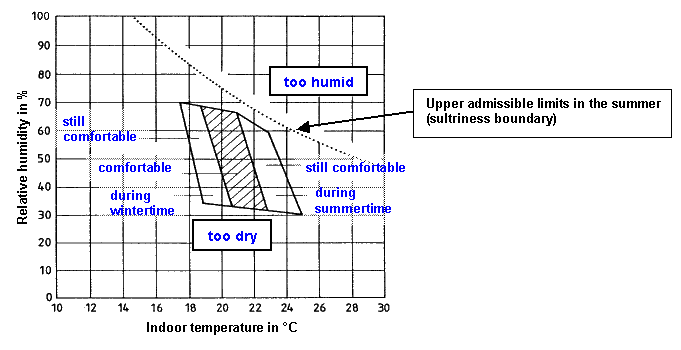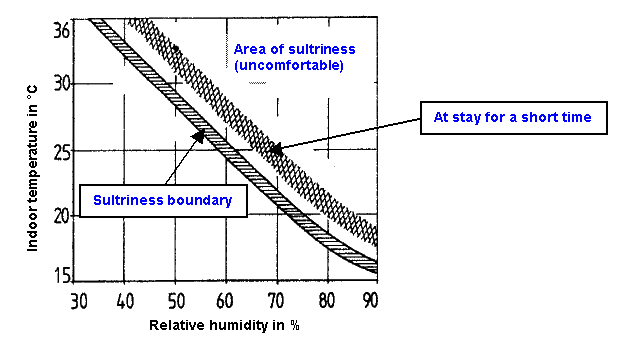
Thermal comfort
General remarks
Thermal comfort is perceived as the comfort of human beings under given room conditions. Because of individual differences of the perception or sensation of humans, an universally valid thermal room climate in which amenity for all is realised, is not producible. A certain number of discontent people will always exist. Therefore, in the ISO 7730, a so called "acceptable thermal room climate" is defined, which is reasonable for at least 80% of all persons staying in it [2].
The consciousness for comfort of human beings depends on conditions for the thermal balance between the body and the environment. It is determined by the following factors:
Physical factors:
Physiologic factors:
The heat produced by the metabolism of the body is transported away by all available physical mechanisms of heat transfer (conduction, convection, radiation, evaporation). The equation of the balance is:
H - Ediff - El - Es - Epe = R + C
The meaning of the variables are (all units in Watt):
|
internal heat production of the body, |
|
latent heat transfer through the skin by diffusion, |
|
latent heat transfer by breathing, |
|
sensible heat transfer by breathing, |
|
latent heat transfer by perspiration evaporation, |
|
radiative heat transfer from the surface of the clothing, |
|
convective heat transfer through the clothing. |
The body adjusts by blood circulation, breathing, skin temperature and perspiration, so that at the currently prevailing conditions the above given balance is always fulfilled. Comfort or discomfort, respectively, is rated according to [1, 2] with the index PMV (predicted mean vote) in a range of values between -3 and +3 (cold, cool, slightly cool, neutral, slightly warm, warm, hot). From the index PMV, the predicted percentage of dissatisfied (PPD) with the given comfort can be calculated. Therefore, IDEA has a tool (Thermal comfort).
A further possibility to characterise the comfort situation is provided by diagrams, in which those areas of the ambient temperature are indicated, in which acceptable PMV or PPD values are achieved. Figure 1 shows such a diagram with the air temperature and the relative humidity as variables. Through such diagrams, the parameter spaces with good or tolerable thermal comfort can be identified.
 |
| Figure 1: Comfort diagram [6]. |
Influence of the humidity
The human organism keeps its body temperature constant at 37 ± 0.5 °C under different inner and outer conditions. To achieve this, the manner and the intensity of the heat transfer from inside to outside must be appropriately modified. Under increased metabolic heat production, the blood circulation in the skin is intensified, which causes a higher surface temperature, and therewith a higher heat transfer. If this is not sufficient, perspiration sets in. Through its evaporation the body is cooled, which is supported by movement of the ambient air. Because perspiration evaporation depends on the pressure gradient between skin surface (saturated vapour pressure) and ambient air (vapour partial pressure) the humidity of the air has an impact on the thermal comfort. The higher the relative humidity, the lower the heat transfer by perspiration evaporation. If the ambient air has a high temperature, in addition to high humidity, it will be sensed as uncomfortable (oppressive) starting at about 11.5 g vapour per kg dry air. This effect occurs at temperatures of 24 °C in conjunction with relative humilities of higher than 60% (see Figure 2). For the indoor humidity, ISO 7730 gives values of 30% to 70%, for which an acceptable comfort is guaranteed.
 |
|
Figure 2: Relation between indoor temperature and relative humidity for different zones of comfort. Upper right: oppressive humidity. Lower left: comfort zone [9]. |
Influence of air movement or air velocity, respectively
The heat balance of human beings is also influenced by air movements or the air velocity in its immediate surroundings. Higher air velocities lead to higher heat transfer at areas of exposed skin and to local cooling of the skin, which is sensed as uncomfortable. At normal room temperatures (20 to 22 °C), acceptable air velocities of 0.1 to 0.2 m/s are given. Apart from the mean air velocity, also the frequency and amplitude of the velocity variations influence the comfort. At the same constant mean air velocity, airflows with high level of turbulence are sensed uncomfortable [4]. In contrast, at high ambient air temperatures and humidity, high air velocities lead to better thermal comfort (ceiling or table fans in summer conditions).
Further influences
In the software tool "Thermal comfort" or in its theoretical foundation (Fanger, [1]), respectively, two influence factors are not included, which are, however, also of importance: These are concerning the vertical temperature gradient and the radiant asymmetry in a room. Both should be as small as possible (vertical gradient: at most about 1 °C/m, radiant asymmetry: smaller than 2.5 °C). In the "ASHRAE Handbook of Fundamentals" [5], results of research can be found regarding the fraction of dissatisfied as a function of air velocity and vertical temperature difference between head and ankle.
Influence of the building properties on the thermal comfort
The parameters, which assure an acceptable thermal comfort, must be made possible by a corresponding planning of a building. The role of the envelope is, among others, to allow the variations of the outdoor temperature only very damped to be transported to the indoor, and also to screen excessive solar radiation to avoid overheating. At the same time, the heat transfer through the envelope must be as small as possible, whereas in the heating season high solar gains through the transparent elements are aspired. To achieve this, while avoiding thermal discomfort, the building envelope must have certain heat insulation properties. These are:
Literature
[1] P. O. Fanger, Thermal comfort, McGraw Hille Book Company, 1973.
[2] EN ISO 7730, Ermittlung des PMV und des PPD und Beschreibung der Bedingungen für thermische Behaglichkeit, ©1995, Europäisches Komitee für Normung (CEN).
[3] Désiré R. Compaoré,
Beitrag zum klimagerechten Bauen in Burkina Faso am Beispiel von Bürobauten,
Bauhaus-Universität Weimar, Dissertation, 2001.
[4] DIN 1946: Raumlufttechnik, Teil 1 bis 7.
[5] 1997 ASHRAE HANDBOOK FUNDAMENTALS (SI Edition),
American Society of Heating, Refrigerating and Air-Conditioning Engineers, Inc.,
1997.
[6] Aktuelle Tabellen Handbuch, Feuchte, Wärme,
Schall mit Formeln und Erläuterungen, Herald Buss, WEKA-Fachverlag GmbH
& Co KG, 1. Auflage 1987.
[7] D. McK. Kerslake, The stress of hot environments,
Cambridge University Press, 1972.
[8] D. A. McIntyre, Indoor Climate, Applied
Science Publishers Ltd, 1980.
[9] Klimatechnik mit Kältetechnik, Claus
Ihle, Band 4, 3. Auflage, Werner-Verlag.